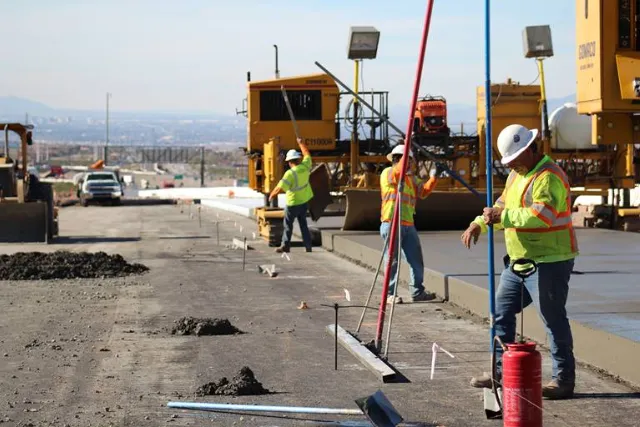
Nevada’s construction industry has long battled blistering temperatures that push crews to work through dangerous midday heat. Now, a new statewide law aims to give workers a fighting chance against the sweltering conditions by allowing construction to start hours earlier than before.
Signed into law by Gov. Joe Lombardo last month, Assembly Bill 478 (AB478) lets commercial and infrastructure construction projects begin work at 5 a.m. from April 1 through September 30 — a significant change from previous local noise ordinances that typically prohibited work before 7 a.m. near homes.

While the early start rule still requires crews to be at least 300 feet away from any occupied residence, it offers contractors more flexibility to schedule physically demanding work during cooler hours.
Before this change, many construction managers felt caught between protecting their crews from heat-related injuries and following local rules designed to limit early-morning noise for residents. Vince Saavedra, executive secretary-treasurer of the Southern Nevada Building Trades Unions, has seen this challenge firsthand.
“It’s a difficult situation and I think elected officials are tasked with a difficult happy medium,” Saavedra said, recalling the numerous calls from contractors desperate to get crews on site before sunrise to avoid the punishing heat. One such project — a wall along a busy freeway — would have benefited greatly from an earlier start but couldn’t move forward due to its proximity to nearby homes.
AB478 had broad support from industry groups such as the Nevada Contractors Association, the Southern Nevada Building and Construction Trade Unions, and the Northern Nevada Building and Construction Trades Council. The measure passed unanimously in both chambers of the Nevada Legislature — an indication of how seriously lawmakers are taking the growing risks posed by extreme heat.
The new law comes in response to an alarming spike in heat-related workplace complaints and fatalities. In 2024, the Nevada Occupational Health and Safety Administration received a record 485 heat-related complaints — the highest in its history. About 5% of those complaints came directly from the construction sector.
In the same year, Clark County alone saw 526 deaths attributed to heat-related causes, setting another grim record that underscored the urgent need for new protective measures.
Construction workers face unique risks when temperatures soar. Beyond the obvious strain of manual labor under direct sun, commercial and infrastructure crews often work over heat-retaining surfaces like asphalt and concrete, which amplify ambient temperatures. Workers also wear protective gear — essential for safety — but it can trap heat and reduce the body’s ability to cool itself.
Sweaty palms, fogged-up safety goggles, and accidental burns from contact with hot metal or equipment are just some of the additional hazards that come with working in the heat. As the National Institute for Occupational Safety and Health points out, one of the most effective strategies to prevent heat-related injuries is simply to shift the work to the coolest parts of the day — something AB478 directly supports.

Assemblymember Sandra Jauregui, who championed the bill, emphasized during hearings that commercial and infrastructure workers deserve the same consideration given to those working on residential projects.
“It’s not fair that those working on pavement to build our highways and roads and infrastructure aren’t protected like our construction workers who are building our homes,” Jauregui said in May. “Those in the commercial construction industry are uniquely susceptible to heat-related injuries. The work comes with inherent risks, which are amplified by exposure to direct sunlight during the hottest months of the year.”
Some local government officials acknowledged the balancing act required by the new rules. Clark County, Nevada’s most populous county, noted that while it did not oppose the measure, it expects to see an increase in noise complaints from residents now hearing heavy equipment before sunrise.
But for many in the construction community, the benefits of protecting workers outweigh the temporary inconvenience of early morning noise. Summer Pellett, who once served on the Storey County Planning Commission, admitted she’d changed her mind about restricting work hours after seeing the impact firsthand as a construction company operator.
“I was simply just trying to reduce noise pollution to residents that were adjacent to construction activity,” Pellett said. “However, I do believe that I was ignorant to the fact that these noise restrictions came at a cost and needlessly required these construction workers to perform manual labor during the heat of the day. It is imperative that we understand that noise pollution related to construction activity is temporary, while heat presents serious health and safety issues to our workforce.”
Nevada’s move aligns with trends in other states also grappling with hotter, longer summers. Arizona, for example, passed a similar law this year allowing construction to begin at 5 a.m. from May through mid-October. These shifts reflect a growing recognition nationwide that climate extremes are pushing industries to rethink how, and when, essential work gets done.
As Nevada’s new law goes into effect, construction crews across the state will have more control over their workdays — and hopefully, better protection from the rising risks of working in a desert climate where triple-digit temperatures have become the norm.
By starting earlier, contractors hope to protect workers’ health, prevent accidents, and ensure that the job still gets done — while balancing the needs of the communities they help build every day.
Originally reported by Jeniffer Solis in Nevada Current.